Having previously been disappointed by the information available on the topic, this is my attempt at categorizing different ways to implement 2D platform games, list their strengths and weaknesses, and discuss some implementation details.
The long-term goal is to make this an exhaustive and comprehensible guide to the implementation of 2D platform games. If you have any sort of feedback, correction, request, or addition – please leave it in the comments!
Disclaimer: some of the information presented here comes from reverse engineering the behavior of the game, not from its code or programmers. It’s possible that they are not ACTUALLY implemented in this way, and merely behave in an equivalent way. Also note that tile sizes are for the game logic, graphical tiles might be of a different size.
Four Ways of Implementing
I can think of four major ways in which a platform game can be implemented. From simplest to most complicated, they are:
Type #1: Tile-based (pure)
Character movement is limited to tiles, so you can never stand halfway between two tiles. Animations may be used to create the illusion of smooth movement, but as far as the game logic is concerned, the player is always right on top of a specific tile. This is the easiest way to implement a platform game, but it imposes heavy restrictions on the control of character, making it unsuitable for traditional action-based platformers. It is, however, popular with puzzle and “cinematographic” platformers.
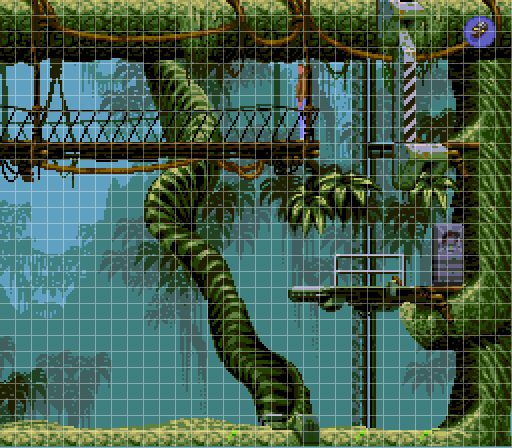 Flashback, shown with tile boundaries
Flashback, shown with tile boundaries
Examples: Prince of Persia, Toki Tori, Lode Runner, Flashback
How it works
The map is a grid of tiles, each one storing information such as whether it’s an obstacle or not, what image to use, what kind of footstep sound to use, and so on. The player and other characters are represented by a set of one or more tiles that move together. In Lode Runner, for example, the player is a single tile. In Toki Tori, the player is 2×2 tiles. In Flashback, which is unusual due to the smaller size of its tiles, the player is two tiles wide and five tiles tall (see image above) when standing, but only three tiles tall when crouching.
In this kind of game, the player will rarely – if ever – be moving diagonally, but, if he is, the movement can be decomposed in two separate steps. Likewise, he will likely only move one tile at once, but multi-tile movement can be done as multiple steps of one tile, if needed (in Flashback, you always move two tiles at once). The algorithm is then as follows:
- Create a copy of the character where he’d like to move to (e.g., if moving one tile to the right, make a copy where every tile of the character is shifted 1 tile to the right)
- Check that copy for intersection with the background and other characters.
- If an intersection is found, the character’s movement is blocked. React accordingly.
- Otherwise, the path is clear. Move character there, optionally playing an animation so the transition looks smooth.
This kind of movement is very ill-suited for traditional arc-shaped jumps – so games in this genre often have no jump at all (Toki Tori, Lode Runner), or only allow vertical or horizontal jumps (Prince of Persia, Flashback), which are nothing but special cases of linear movement.
Advantages of this system include simplicity and precision. Since the games are more deterministic, glitches are much less likely, and the gameplay experience is more controlled, with less of a need to tweak values depending on circumstances. Implementing certain mechanics (such as grabbing ledges and one-way platforms) becomes a breeze, compared to more complex movement styles – all you have to do is check whether the player tiles and the background tiles are aligned in the one specific way that allows for a given action.
In principle, this system doesn’t allow steps of less than one tile, but that can be mitigated in a few different ways. For example, the tiles can be a bit smaller than the player (say, a player is 2×6 tiles), or you can allow a visual-only movement to take place inside a given tile, without affecting the logic (which is the solution that I believe that “Lode Runner – The Legend Returns” takes).
Type #2: Tile Based (Smooth)
Collision is still determined by a tilemap, but characters can move freely around the world (typically with 1px resolution, aligned to integers, but see the note at the end of article regarding smoothing of movement). This is the most common form of implementing platformers in 8-bit and 16-bit consoles, and remains popular today, as it is still easy to implement and makes level editing simpler than more sophisticated techniques. It also allows for slopes and smooth jump arcs.
If you’re unsure which type of platformer you want to implement, and you want to do an action game, I suggest going for this one. It’s very flexible, relatively easy to implement, and gives you the most control of all four types. It’s no wonder that the majority of the best action platformers of all time are based on this type.
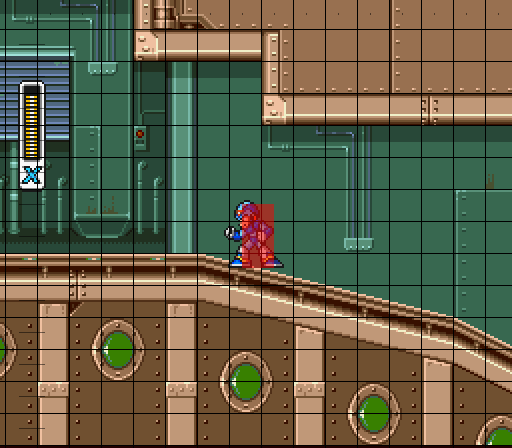 Mega Man X, shown with tile boundaries and player hitbox.
Mega Man X, shown with tile boundaries and player hitbox.
Examples: Super Mario World, Sonic the Hedgehog, Mega Man, Super Metroid, Contra, Metal Slug, and practically every platformer of the 16-bit era
How it works
Map information is stored in the same way as with the pure tile technique, the difference is merely in how the characters interact with the background. The character’s collision hitbox is now an Axis-Aligned Bounding Box (AABB, that is, a rectangle that cannot be rotated), and are typically still an integer multiple of tile size. Common sizes include one tile wide and one (small Mario, morph ball Samus), two (big Mario, Mega Man, crouched Samus) or three (standing Samus) tiles tall. In many cases, the character sprite itself is larger than the logical hitbox, as this makes for a more pleasant visual experience and fairer gameplay (it’s better for the player to avoid getting hit when he should have than for him to get hit when he should not have). In the image above, you can see that the sprite for X is square-ish (in fact, is two tiles wide), but his hitbox is rectangular (one tile wide).
Assuming that there are no slopes and one-way platforms, the algorithm is straightforward:
- Decompose movement into X and Y axes, step one at a time. If you’re planning on implementing slopes afterwards, step X first, then Y. Otherwise, the order shouldn’t matter much. Then, for each axis:
- Get the coordinate of the forward-facing edge, e.g. : If walking left, the x coordinate of left of bounding box. If walking right, x coordinate of right side. If up, y coordinate of top, etc.
- Figure which lines of tiles the bounding box intersects with – this will give you a minimum and maximum tile value on the OPPOSITE axis. For example, if we’re walking left, perhaps the player intersects with horizontal rows 32, 33 and 34 (that is, tiles with y = 32 * TS, y = 33 * TS, and y = 34 * TS, where TS = tile size).
- Scan along those lines of tiles and towards the direction of movement until you find the closest static obstacle. Then loop through every moving obstacle, and determine which is the closest obstacle that is actually on your path.
- The total movement of the player along that direction is then the minimum between the distance to closest obstacle, and the amount that you wanted to move in the first place.
- Move player to the new position. With this new position, step the other coordinate, if still not done.
Slopes
Slopes (the tiles pointed by green arrows on the image above) can be very tricky, because they are obstacles, and yet still allow the character to move into their tile. They also cause movement along the X axis to adjust position on the Y axis. One way to deal with them is to have the tile store the “floor y” of either side. Assuming a coordinate system where (0, 0) is at top-left, then the tile just left of X (first slope tile) is {0, 3} (left, right), then the one he stands on is {4, 7}, then {8, 11}, then {12, 15}. After that, the tiles repeat, with another {0, 3}, etc, and then we have a steeper slope, composed of two tiles: {0, 7} and {8, 15}.
The system that I’m going to describe allows arbitrary slopes, though for visual reasons, those two slopes are the most common, and result in a total of 12 tiles (the 6 described previously, and their mirrorings). The collision algorithm changes as follows for horizontal movement:
- Make sure that you step X position before Y position.
- During collision detection (4 above), the slope only counts as a collision if its closest edge is the taller (smaller y coordinate) one. This will prevent characters from “popping” through the slope from the opposite side.
- You might want to forbid slopes to stop “halfway through” (e.g. on a {4, 7} tile). This restriction is adopted by Mega Man X and many other games. If you don’t, you have to deal with the more complicated case of the player attempting to climb from the lower side of the slope tile – one way to deal with this is to pre-process the level, and flag all such offending tiles. Then, on collision detection, also count it as a collision from the lower side if the player’s lowest y coordinate is greater (that is, below) the tile’s offset edge (tile coord * tile size + floor y).
- A full obstacle tile adjacent to the slope the character is currently on should not be considered for collision if it connects to the slope, that is, if the character (that is, his bottom-center pixel) is on a {0, *} slope, ignore left tile, and, if on a {*, 0} slope, ignore the right tile. You may have to do this for more tiles if your character is wider than two tiles – you might simply skip checking on the entire row if the player is moving towards the upper side of slope. The reason for this is to prevent the character from getting stuck at those tiles (highlighted yellow above) while still climbing the slope, as his foot will still be below the “surface level” by the time he comes into contact with the otherwise solid tile.
And for vertical movement:
- If you’re letting gravity do its job for downhill movement, make sure that the minimum gravity displacement is compatible with slope and horizontal velocity. For example, on a 4:1 slope (as {4, 7} above), the gravity displacement must be at least 1/4 of the horizontal velocity, rounded up. On a 2:1 slope (such as {0, 7}), at least 1/2. If you don’t ensure this, the player will move horizontally right off the ramp for a while, until gravity catches up and drags him down, making him bounce on the ramp, instead of smoothly descending it.
- An alternative to using gravity is to compute how many pixels above floor the player was before movement, and how many it is afterwards (using the formula below), and adjust his position so they’re the same.
- When moving down, instead of considering a slope tile’s top edge as its collision boundary, instead, compute its floor coordinate at the current vertical line, and use that. To do that, find the [0, 1] value which represents the player’s x position on tile (0 = left, 1 = right) and use it to linearly interpolate the floorY values. The code will look something like:Â
float t = float(centerX - tileX) / tileSize; float floorY = (1-t) * leftFloorY + t * rightFloorY;
- When moving down, if multiple tiles on the same Y coordinate are obstacle candidates, and the one on the X coordinate of the player’s center is a slope tile, use that one, and ignore the rest – even though the others are technically closer. This ensures proper behaviour around the edges of slopes, with the character actually “sinking” on a completely solid tile because of the adjacent slope.
One-way platforms
One-way platforms are platforms that you can step on, but you can also jump through them. In other words, they count as an obstacle if you’re already on top of them, but are otherwise traversable. That sentence is the key to understanding their behavior. The algorithm changes as follows:
- On the x axis, the tile is never an obstacle
- On the y axis, the tile is only an obstacle if, prior to the movement, the player was entirely above it (that is, bottom-most coordinate of player was at least one pixel above top-most coordinate of one-way platform). To check for this, you will probably want to store the original player position before doing any stepping.
It might be tempting to have it act as an obstacle if the player’s y speed is positive (that is, if the player is falling), but this behavior is wrong: it’s possible for the player to jump so he overlaps the platform, but then falls down again without having his feet reach the platform. In that case, he should still fall through.
Some games allow the player to “jump down” from such platforms. There are a few ways to do this, but they are all relatively simple. You could, for example, disable one-way platforms for a single frame and ensure that y speed is at least one (so he’ll be clear of the initial collision condition on the next frame), or you could check if he’s standing exclusively on one-way platforms, and, if so, manually move the player one pixel to the bottom.
Ladders
 Mega Man 7, with tile boundaries, highlighted ladder tiles, and player ladder hitbox.
Mega Man 7, with tile boundaries, highlighted ladder tiles, and player ladder hitbox.
Ladders might seem complicated to implement, but they are simply an alternate state – when you’re in a ladder, you ignore most of the standard collision system, and replace it with a new set of rules. Ladders are typically one tile wide.
You can usually enter the ladder state in two ways:
- Have your character hitbox overlap with the ladder, either on ground or on air, and hit up (some games also allow you to hit down)
- Have your character stand on top of a “ladder top” tile (which is often a one-way platform tile as well, so you can walk on top of it), and hit down.
This has the effect of immediately snapping the player’s x coordinate to align with the ladder tiles, and, if going down from the top of ladder, move y coordinate so player is now inside the actual ladder. At this point, some games will use a different hitbox for the purposes of determining whether the player is still on the ladder. Mega Man, for example, seems to use a single tile (equivalent to top tile of the original character, highlighted in red in the image above).
There are a few different ways of LEAVING the ladder:
- Reaching the top of the ladder. This will usually prompt an animation and move the player several pixels up in y, so he’s now standing on top of the ladder.
- Reaching the bottom of a hanging ladder. This will cause the player to simply fall, although some games won’t let the player leave the ladder in this way.
- Moving left or right. If there is no obstacle on that side, the player may be allowed to leave that way.
- Jumping. Some games allow you to release the ladder by doing this.
Stairs
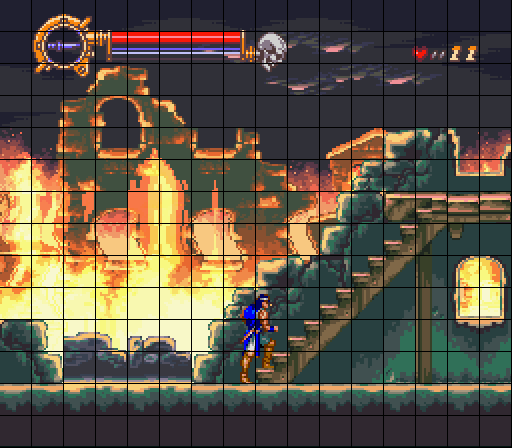 Castlevania: Dracula X, with tile boundaries
Castlevania: Dracula X, with tile boundaries
Stairs are a variation of ladders, seen in few games, but notably in the Castlevania series. The actual implementation is very similar to that of ladders, with a few exceptions:
- The player moves tile by tile or half-tile by half-tile (as in Dracula X)
- Each “step” causes the player to be shifted simultaneously on X and Y coordinates, by a preset amount.
- Initial overlapping detection when going up might look on the tile ahead instead of just the current overlap one.
Moving Platforms
Moving platforms can seem a little tricky, but are actually fairly simple. Unlike normal platforms, they cannot be represented by fixed tiles (for obvious reasons), and instead should be represented by an AABB, that is, a rectangle that cannot be rotated. It is a normal obstacle for all collision purposes, and if you stop here, you’ll have very slippery moving platforms (that is, they work as intended, except that the character does not move along it on his own).
There are a few different ways to implement that. One algorithm is as follows:
- Before anything on the scene is stepped, determine whether the character is standing on a moving platform. This can be done by checking, for example, whether his center-bottom pixel is just one pixel above the surface of the platform. If it is, store a handle to the platform and its current position inside the character.
- Step all moving platforms. Make sure that this happens before you step characters.
- For every character that’s standing on a moving platform, figure the delta-position of the platform, that is, how much it has moved along each axis. Now, shift the character by the same amount.
- Step the characters as usual.
Other Features
Other games have more complicated and exclusive features. Sonic the Hedgehog series is notable for this. Those are beyond the scope of this article (and my knowledge, for that matter!), but might be subject of a future article.
Type #3: Bitmask
Similar to “Tile Based (Smooth)”, but instead of using large tiles, an image is used to determine collision for each pixel. This allows finer detailing, but significantly increases complexity, memory usage, and requires something akin to an image editor to create levels. It also often implies that tiles won’t be used for visuals, and may therefore require large, individual artwork for each level. Due to those issues, this is a relatively uncommon technique, but can produce higher quality results than tile-based approaches. It is also suitable for dynamic environments – such as the destructible scenarios in Worms – as you can “draw” into the bitmask to change the scenario.
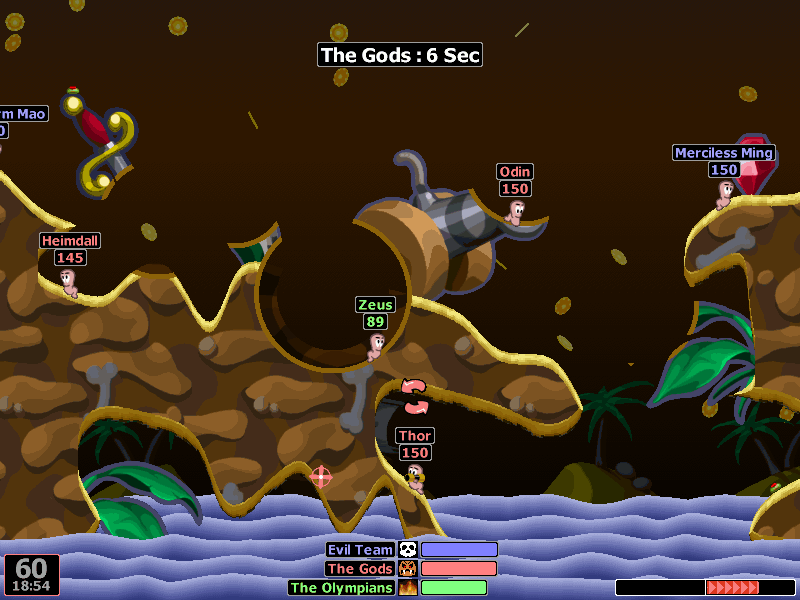 Worms World Party, featuring destructible terrain
Worms World Party, featuring destructible terrain
Examples: Worms, Talbot’s Odyssey
How it works
The basic idea is very similar to the tile (smooth) algorithm – you can simply consider each pixel to be a tile, and implement the exact same algorithm, and everything will work, with one major exception – slopes. Since slopes are now implicitly defined by the positioning between nearby tiles, the previous technique doesn’t work, and a much more complex algorithm has to be used in its place. Other things, such as ladders, also become trickier.
Slopes
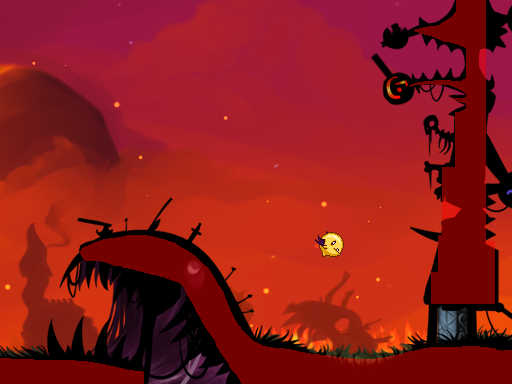 Talbot’s Odyssey, with the collision bitmask overlaid on top of the game.
Talbot’s Odyssey, with the collision bitmask overlaid on top of the game.
Slopes are the primary reason why this type of implementation is very hard to get right. Unfortunately, they are also pretty much mandatory, as it’d make no sense to use this implementation without slopes. Often, they’re the reason why you’re even using this system.
This is, roughly, the algorithm used by Talbot’s Odyssey:
- Integrate acceleration and velocity to compute the desired delta-position vector (how much to move in each axis).
- Step each axis separately, starting with the one with the largest absolute difference.
- For the horizontal movement, offset the player AABB by 3 pixels to the top, so he can climb slopes.
- Scan ahead, by checking against all valid obstacles and the bitmask itself, to determine how many pixels it is able to move before hitting an obstacle. Move to this new position.
- If this was horizontal movement, move as many pixels up as necessary (which should be up to 3) to make up for slope.
- If, at the end of the movement, any pixel of the character is overlaping with any obstacle, undo the movement on this axis.
- Regardless of result of last condition, proceed to do the same for the other axis.
Type #4: Vectorial
This technique uses vectorial data (lines or polygons) to determine the boundaries of collision areas. Very difficult to implement properly, it is nevertheless increasingly popular due to the ubiquity of physics engines, such as Box2D, which are suitable for implementing this technique. It provides benefits similar to the bitmask technique, but without major memory overhead, and using a very different way of editing levels.
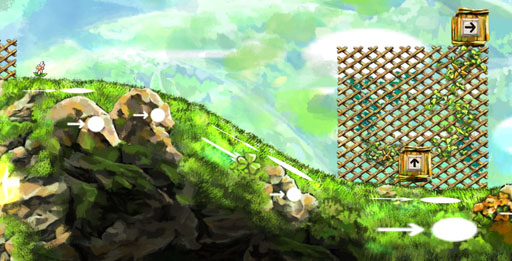
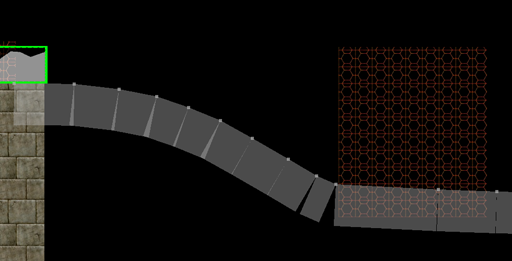 Braid (level editor), with visible layers (top) and the collision polygons (bottom)
Braid (level editor), with visible layers (top) and the collision polygons (bottom)
Examples: Braid, Limbo
How it works
There are two general ways of approaching this:
- Resolve movement and collisions yourself, similar to the bitmask method, but using polygon angles to compute deflection and have proper slopes.
- Use a physics engine (e.g. Box2D)
Obviously, the second is more popular (though I suspect that Braid went for the first), both because it is easier and because it allows you to do many other things with physics in the game. Unfortunately, in my opinion, one has to be very careful when going this route, to avoid making the game feel like a generic, uninteresting physics-platformer.
Compound objects
This approach has its own unique problems. It may suddenly be difficult to tell whether the player is actually standing on the floor (due to rounding errors), or whether it’s hitting a wall or sliding down a steep incline. If using a physics engine, friction can be an issue, as you’ll want friction to be high on the foot, but low on the sides.
There are different ways to deal with those, but a popular solution is to divide the character into several different polygons, each with different roles associated: so you’d (optionally) have the main central body, then a thin rectangle for feet, and two thin rectangles for sides, and another for head or some similar combination. Sometimes they are tapered to avoid getting caught into obstacles. They can have different physics properties, and collision callbacks on those can be used to determine the status of character. For more information, sensors (non-colliding objects that are just used to check for overlap) can be used. Common cases include determinining whether we’re close enough to the floor to perform a jump, or if the character is pushing against a wall, etc.
General Considerations
Regardless of the type of platform movement that you have chosen (except perhaps for type #1), a few general considerations apply.
Acceleration
 Super Mario World (low acceleration), Super Metroid (mid acceleration), Mega Man 7 (high acceleration)
Super Mario World (low acceleration), Super Metroid (mid acceleration), Mega Man 7 (high acceleration)
One of the factors that affects the feel of a platformer the most is the acceleration of the character. Acceleration is the rate of change in speed. When it is low, the character takes a long time to reach its maximum velocity, or to come to a halt after the player lets go of controls. This makes the character feel “slippery”, and can be hard to master. This movement is most commonly associated with the Super Mario series of games. When the acceleration is high, the character takes very little (or no time) to go from zero to maximum speed and back, resulting in very fast responding, “twitchy” controls, as seen in the Mega Man series (I believe that Mega Man actually employs infinite acceleration, that is, you’re either stopped or on full speed).
Even if a game has no acceleration on its horizontal movement, it is likely to have at least some for the jump arcs – otherwise they will be shaped like triangles.
How it works
Implementing acceleration is actually fairly simple, but there are a few traps to watch out for.
- Determine xTargetSpeed. This should be 0 if the player is not touching the controls, -maxSpeed if pressing left or +maxSpeed if pressing right.
- Determine yTargetSpeed. This should be 0 if the player is standing on a platform, +terminalSpeed otherwise.
- For each axis, accelerate the current speed towards target speed using either weighted averaging or adding acceleration.
- Weighted averaging: acceleration is a number (“a”) from 0 (no change) to 1 (instant acceleration). Use that value to linearly interpolate between target and current speed, and set the result as current speed.
vector2f curSpeed = a * targetSpeed + (1-a) * curSpeed; if (fabs(curSpeed.x) < threshold) curSpeed.x = 0; if (fabs(curSpeed.y) < threshold) curSpeed.y = 0;
- Adding acceleration: We’ll determine which direction to add the acceleration to (using the sign function, which returns 1 for numbers >0 and -1 for <0), then check if we overshot.
vector2f direction = vector2f(sign(targetSpeed.x - curSpeed.x),
sign(targetSpeed.y - curSpeed.y));
curSpeed += acceleration * direction;
if (sign(targetSpeed.x - curSpeed.x) != direction.x)
curSpeed.x = targetSpeed.x;
if (sign(targetSpeed.y - curSpeed.y) != direction.y)
curSpeed.y = targetSpeed.y;
Jump control
 Super Metroid, Samus performing the “Space Jump” (with “Screw Attack” power-up)
Super Metroid, Samus performing the “Space Jump” (with “Screw Attack” power-up)
Jumping in a platform game can be as simple as checking if the player is on the ground (or, often, whether he was on the ground anytime on the last n frames), and, if so, giving the character an initial negative y speed (in physical terms, an impulse) and letting gravity do the rest.
There are four general ways in which the player can control the jump:
- Impulse: seen in games such as Super Mario World and Sonic the Hedgehog, the jump preserves the momentum (that is, in implementation terms, the speed) that the character had before the jump. In some games, this is the only way to influence the arc of the jump – just like in real life. There is nothing to implement here – it will be like this unless you do something to stop it!
- Aerial acceleration: that is, retaining control of horizontal movement while in mid-air. Though this is physically implausible, it is a very popular feature, as it makes the character much more controllable. Almost every platformer game has it, with exceptions for games similar to Prince of Persia. Generally, the airborne acceleration is greatly reduced, so impulse is important, but some games (like Mega Man) give you full air control. This is generally implemented as merely tweaking the acceleration parameter while you’re airborne.
- Ascent control: another physically implausible action, but very popular, as it gives you much greater control over the character. The longer you hold the jump button, the higher the character jumps. Typically, this is implemented by continuing to add impulse to the character (though this impulse can incrementally decrease) for as long as the button is held, or alternatively by suppressing gravity while the button is held. A time limit is imposed, unless you want the character to be able to jump infinitely.
- Multiple jumps: once airborne, some games allow the player to jump again, perhaps for an unlimited number of times (as in the Space Jump in Super Metroid or the flight in Talbot’s Odyssey), or for a limited number of jumps before touching the ground (“double jump” being the most common choice). This can be accomplished by keeping a counter that increases for each jump and decreases when you’re on the ground (be careful when you update this, or you might reset it right after the first jump), and only allowing further jumps if the counter is low enough. Sometimes, the second jump is shorter than the initial one. Other restrictions may apply – the Space Jump only triggers if you’re already doing a spin jump and just began to fall.
Animations and leading
 Black Thorne, character doing a long animation before shooting backwards (Y button)
Black Thorne, character doing a long animation before shooting backwards (Y button)
In many games, your character will play an animation before actually performing the action you requested. However, on a twitchy action-based game, this will frustrate players – DON’T DO THAT! You should still have leading animations for things such as jumping and running, but if you care about how the game responds, make those cosmetic only, with the action taken immediately regardless of the animation.
Smoother movement
Using integers to represent the position of the characters is wise, as it makes it faster and stable. However, if you use integers for everything, you will end up with some jerky motion. There are multiple solutions to this. These are a few:
- Use a float for all computations and for storing position, and cast to int whenever you’re rendering or computing collisions. Fast and simple, but it starts losing precision if you move too far away from (0,0). This is probably not relevant unless you have a very large playfield, but it’s something to keep in mind. If it comes to it, you can use a double instead.
- Use a fixed point number for all computations and position, and again cast to int when you’re rendering or computing collisions. Less precise than float and with a more limited range, but the precision is uniform and can, on some hardware, be faster (notably, floating point processing is slow on many mobile phones).
- Store position as an integer, but keep a “remainder” stored in a float. When integrating position, compute the delta-movement as a float, add the remainder to the delta-movement, then add the integer part of this value to the position, and the fractional part to the “remainder” field. On the next frame, the remainder will get added back in. The advantage of this method is that you’re using an integer everywhere except for movement, ensuring that you won’t have floating point complications elsewhere, and increasing performance. This technique is also very suitable if you have some framework in which the position of the object has to be an integer, or where it is a float, but that same position is used directly by the rendering system – in that case, you can use the framework-provided float position to store integer values only, to make sure that the rendering is always aligned to pixels.

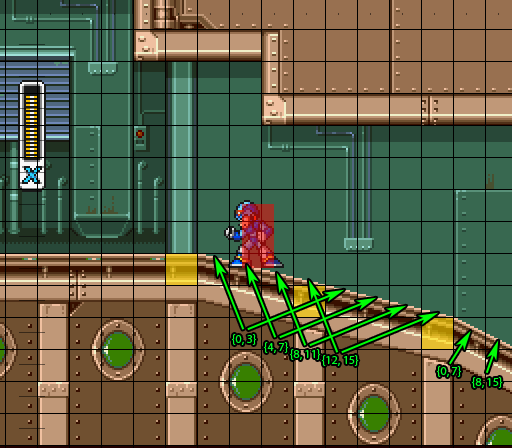

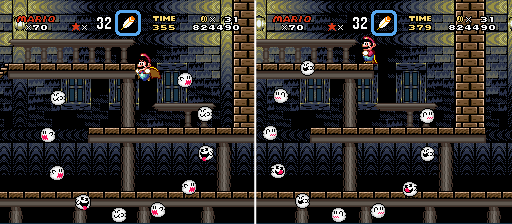



Porter
/ 2012-09-04Absolutely amazing write-up. Not only did you touch in an amazing number of key subjects, you also used examples from a large collection of my favorite games. Site bookmarked, keep up the good work.
Jonny D
/ 2012-09-05Great article!
Concerning jump ascent control, I don’t think games typically “add impulse” or “disable gravity”. It’s simpler and probably more common to chop the vertical velocity down to a low constant value (if vel is higher than that value). That way there’s still some arc left in the jump, but it doesn’t rise much more after you release the button.
java blog
/ 2012-10-03One of the very best article I have ever seen. So many information which is effectively complemented by cool pictures. Simply amazing. Thanks a ton to you man.
Savingfunda
/ 2012-10-05Amazing stuff, extensive, informative and well written. worth sharing and bookmarking.
Greg
/ 2012-10-09Hoping to see many more articles from this site.. really love the way you explain the basic concepts, makes it easy to port to any language..
Guilherme
/ 2012-10-23That’s some great article, bookmarked and will be using it in my first game.
The only part I got a bit confused was the slope part, and It’s not your fault, it’s just that I’m a beginner.
Do you know where I could learn more about slopes? I’m developing a little game for learning purposes and I want to use 45º slopes in it, but I just can’t seem to think about how i’ll do it. I’m using Mappy to edit the tiles and show them in my game.
Thanks for the article.
DaveB
/ 2012-10-23Really dig the article, man. Great write-up on any and all of the various things one could implement in a 2D platformer. I’ve actually been trying to make note of the topics you covered using Mega Man X as an example, though I’m having trouble translating your process into my existing update loop. Still, very informative!
Daniel
/ 2012-11-01cool site, bookmarked !
Mike
/ 2012-11-14Thank you for this article. Very informative!
Siro
/ 2012-11-21Thank you for this guide, it is amazing…
Orktech
/ 2012-11-26Vectorial is deffinetly the best way to make levels, I believe. I’m using Unity3d and Blender for this stuff – charming and easier then tiles.
For those who loves tiles try a http://www.mapeditor.org/ It’s very simple tile editor for orthogonal and isometric maps. And it supports several level formats which can be read by Cocos2dx.
Domarius
/ 2013-01-06This is so perfect and thorough, and I know it’s accurate to the way things were done in the original platformers. This info is still relevant today if we want to push the limits of what the game can do in order for it to run fast, especially on mobile devices. It’s a breath of fresh air after wading through various articles made by people who are just fumbling their way through pieces of hearsay.
OmegaWarrior
/ 2013-01-27I found some of the stuff on implementing sloped tiles, to be quite helpful, but if you don’t mind, I have a few thing to add to the article:
– Another way to allow the player to fall through a one-way platform is to simply add a condition that they are not pressing the button combination for jumping down when resolving along the Y-Axis (e.g., if(collision == TileType.Platform && !ButtonPressed(Buttons.Down | Buttons.A)) {…}
– There is one other condition in which a sprite typically leaves a Ladder: Taking Damage
– You mentioned that you didn’t know how tile checking worked in Sonic the Hedgehog; I’ve found another page that has an in-depth study on that topic: http://info.sonicretro.org/Sonic_Physics_Guide
Wonkyth
/ 2013-01-28What a fantastic article! 😀
Now I finally have a page that I can throw at people when they ask me how2thing. ^__^
I was about to mention that Sonic Physics Guide on Sonic Retro, then noticed that OmegaWarrior had already posted it! 😀
One other thing which might be useful is this: http://www.niksula.hut.fi/~hkankaan/Homepages/gravity.html
^how to implement gravity so that it stays practically the same regardless of framerate.
Mau
/ 2013-02-08Holy crap… this was AMAZING!!
You’ve touched on SO many interesting topics here and explained things in such a simple manner that I’m probably going to prepare a whole University course primarily based on what was discussed in this article!! Thanks for sharing your knowledge and your time!
Loughlin
/ 2013-02-25Possibly one of the best articles I’ve read on this subject. I’m working with ImpactJS at the moment – really finding it intuitive but it’s the long established principals discussed in this article that I find are pure gold when it comes to developing a game that not only plays well but has that instant feel of quality. MORE!!!!
Palifael
/ 2013-03-10Great Article!
Vinicius
/ 2013-03-12Really good article.
However, I’m still struggling for months to get type #2 work. Couldn’t find a way to implement the closest-edge direction and it always result on glitches and unprecise collision.
Can you give me some directions on more stuff to read?
odu
/ 2013-04-16Kudos to you guys. I not know any thing in coding i want to be a game developer . What can i do.? What Programming do i need must? C++ or java. Please help me
Alcocapok
/ 2013-04-30Asked a short while ago to write down about alternative smoking herbs , I have to confess that I’d hardly ever listened to of these kinds of a thing. Some world wide web study later and i found out that e-cigarettes are very substantially a swiftly expanding problem. A Google search discovered there exists no smoke with out fireplace as nearly 6 million effects just for the phrase “electronic cigarette” had been returned.
What’s an e-cigarette?
The electronic cigarette has long been in existence for nearly 3 several years and it is a intelligent product targeted at offering smokers which has a much healthier solution. Seemingly also valuable in assisting to reduce and in truth stop smoking cigarettes entirely.
Now within a fourth era, e-cigs have become much extra user helpful than before variations which maybe ended up a little bit very substantial to stimulate a mass current market attraction. The “mini” is the most sensible e cigarette to this point with its duration of 100mm currently being similar to a conventional cigarette.
An electronic cigarette incorporates a flavor of tobacco but none of the harmful substances identified in ordinary cigarettes permitting people who smoke cravings for being happy with no inhaling the many unsafe toxins. Could it be all smoke and mirrors? Or can this merchandise really be the saviour it would like to be?
A battery, an atomiser and a renewable nicotine chamber allows the smoker to carry and smoke the electronic cigarette equally as they’d another cigarette, even making a “smoke” like vapour and glow for the close because they attract. The nicotine chamber proves quite valuable as cartridges are available in several strengths, allowing the user to lessen the amount of nicotine they intake right until should they hope, can give up absolutely.
A nicotine cartridge generally lasts the identical time as fifteen to twenty cigarettes, hence developing a huge conserving to standard expenses. Typical, medium, minimal and no nicotine whatsoever are classified as the a variety of cartridge strengths.
A more healthy choice entirely it seems, although the advantages don’t close there. Due to e-cigarette not emitting any perilous substances, poisons or actual smoke for instance, they are completely lawful to smoke in public. In wintertime especially, regular cigarette people who smoke really have to brave the freezing chilly plus the rain just for a fast smoking break but this substitute enables them to remain of their offices, dining places and pubs.
None people who smoke also will gain, as their problems about passive using tobacco are rendered null and void with the ecigarette. A way more sociable atmosphere then!
Upon reflection the ecigarette is a much healthier, more cost-effective and eco-friendly different to using tobacco and as the awareness as well as the marketplace grows they’ve fantastic prospective to properly swap the hazardous cigarettes we have now all arrive to know and many of us have come to dread and concern.
Decroded
/ 2013-05-02I code this so when jump is held, vertical speed is set to a negative amount.
The effect of gravity is disabled while jump is held.
This continues each step until the jump-hold counter goes off or player releases the button (or hit roof etc etc).
Then gravity kicks in and modifies the vertical speed accordingly.
Works really well.
Decroded
/ 2013-05-02Start with Game Maker Studio.
It has a great free version for beginners and very active community for support and examples.
link shortner
/ 2013-05-08Hi there, yeah this post is genuinely fastidious and I have learned lot of things from it about blogging.
thanks.
Rodaraujo
/ 2013-08-09Great Article, very insightful, but does this apply to 2D games with 3D graphics like the new Donkey Kong Country Returns game on the Wii? I’ve heard people saying it’s better to implement the movement yourself rather than letting a physics simulator handle it, but is it the same with 3D surfaces? The only way I’ve come to think of implementing it yourself is by casting vectors from the character to the outside in order to detect collisions, but isn’t this just the same as a 3D physics engine? I’d appreciate it if you could point me in the right way, I’m making a 2.5D game using a physics simulator engine but I don’t know if it is the best way to do it.
Princess
/ 2013-09-21It’s awesome to go to see this site and reading the views of all
friends concerning this paragraph, while I am
also zealous of getting experience.
snapdeal coupon code
/ 2013-09-24You can make use of different offers in different states as well adding to your
convenience. The absence of chemicals is what makes the henna tattoo a much sought after temporary
tattoo. They have gone a long way from the age of
the computers and are today enjoying their lives in a different
way. s stiff competition of e-commerce sites, online shoppers
may easily get the best deals, offers, and free coupons
that will be helpful to meet your requirements.
Chris
/ 2013-10-05Nice article. Another entry in the Bitmask theme is of course lemmings: http://www.javalemmings.com/DMA/Lem_2.htm even describes how the team literally integrated Deluxe Paint into the level editor.
gold mining stocks
/ 2013-10-25Hmm is anyone else having problems with the images on this blog loading?
I’m trying to find out if its a problem on my end or if it’s the
blog. Any feed-back would be greatly appreciated.
filairsoft.com
/ 2013-11-15�
nieprzychylnie. ÅypnÄ…Å‚ spod oka. Drogocenna budowa. – Stanąć!
– warknÄ…Å‚.
Bez budowa (filairsoft.com) sensu. Pozbawiony wolności, odkąd paru chwil apatryda,
również tak bardzo stał.
– Na odpornoÅ›ci itd., administruje siÄ™ konfiskatÄ™ majÄ…tku na wierzch kosztów
przewoduplus wyżywienia… Usiąść!
Popatrzył na boki.
– Koniec! – powiadaÅ‚. – Również tak bardzo zasxobem informacji, o co chodzi, Zydyy pazerne…
Cywile zarechotali. Uwięziony także się uśmiechnął.
Umie.
Budowanie
/ 2013-11-15� nadzieję.
– Pieprz siÄ™, Wart uwagi budowa. dupku – wychrypiaÅ‚ Budowanie na wdechu.
– Co, powiesz chyba, że ciÄ™ figa nie
obchodzi? Owszem, zauważymy, dojrzejemy. Toż najpierw spróbujemy
tradycyjnie. Raptem,bez zamachu wpakował pięść w żołądek niziołka.
Nogi Froda
zadrgały, piętami wybijając kusy werbel na ścianie.
Podczas gdy wprzódy umiał percypować a także odbierać
byt, spędzał przyklejony taśmą samoprzylep.
modeling agency
/ 2013-12-05Why users still make use of to read newes papers when in this
technological globe the whole thing iis existing on net?
Kellie
/ 2014-01-02amtąd na Natomiast owe będziesz wyłapała solidnego baba.
nieuszkodzony
świat. Przecież drzewko nie potrzebuje byt web page
(Kellie) promieniować. Głowa kościoła jakby
dziękuje, jakkolwiek pewno, że wyraz twarzy
mu rzednie. Znikoma myśl. Dalszy
kiedyś natychmiast nie chce się nam unosić się w powietrzu.
“PomyliÅ‚aÅ› drzewka! ” –
wrzeszczy Oleg na VerÄ™. “Nie wrzeszcz na mnie! ” –
wrzeszczy Vera. “Stulcie mordy! ” – wrzeszczy Bob (lite
zbieg okoliczności, że Ojciec święty nie słucha tą
prawdziwej cyrkulacji zdaÅ„). –
“Trzeba.
Brad O'Hearne
/ 2014-03-27Major kudos for this post! This was one of, if not the most interesting, informative, and pragmatically helpful posts on game development that I have ever read. This is gold — I highly recommend that you further expand the discussions of the details, problems encountered, and alternative solutions to those problems, and turn this into a full book on platformer game development. I’d be the first in line to buy it. I think if you wanted to expand even further with discussions on specific implementations on platforms like SpriteKit, Unity, GameMaker Studio, etc., you probably have the makings of a great training course as well. Really well done. Thanks for investing your time and thoughts into a great piece of reading — made my morning reading and coffee extra enjoyable today!
Cheers,
Brad
Karan Sequeira
/ 2014-04-28Thanks a lot Rodrigo. This was definitely one of the best articles on the subject that I have come across. The amount of simplistic yet extensive detail that you have documented here is much appreciated. Keep up the good work dude.
Heriberto
/ 2014-05-01This paragraph is truly a nice one it helps
new web people, who are wishing for blogging.
retro16
/ 2014-05-23For those who wish to know more about Sonic games, the Sonic Retro website has a great in-depth description on how to do it :
http://info.sonicretro.org/Sonic_Physics_Guide
Sonic is probably the most complex 2D platformer ever made, and this website just shows it.
Divina Gatchel
/ 2014-06-27I have to tell you that it’s hard to find your articles in google,
i found this one on 11 spot, you should build some quality backlinks in order
to rank your page, i know how to help you, just search in google – k2 seo tips and tricks
personal injury claims
/ 2014-07-17Howdy! I know this is somewhat off topic but I was wondering which blog platform are you using for this website?
I’m getting fed up of WordPress because I’ve had problems with hackers and I’m looking at alternatives for another
platform. I would be fantastic if you could point me in the direction of
a good platform.
minecraft pocket edition download
/ 2014-07-22I know this if off topic but I’m looking into starting my own weblog
and was curious what all is needed to get set up?
I’m assuming having a blog like yours would cost a pretty
penny? I’m not very web savvy so I’m not 100% positive.
Any suggestions or advice would be greatly appreciated.
Cheers
gyozo
/ 2014-08-09Decompose movement into X and Y axes, step one at a time. If you’re planning on implementing slopes afterwards, step X first, then Y. Otherwise, the order shouldn’t matter much. Then, for each axis:
Get the coordinate of the forward-facing edge, e.g. : If walking left, the x coordinate of left of bounding box. If walking right, x coordinate of right side. If up, y coordinate of top, etc.
Figure which lines of tiles the bounding box intersects with – this will give you a minimum and maximum tile value on the OPPOSITE axis. For example, if we’re walking left, perhaps the player intersects with horizontal rows 32, 33 and 34 (that is, tiles with y = 32 * TS, y = 33 * TS, and y = 34 * TS, where TS = tile size).
Scan along those lines of tiles and towards the direction of movement until you find the closest static obstacle. Then loop through every moving obstacle, and determine which is the closest obstacle that is actually on your path.
The total movement of the player along that direction is then the minimum between the distance to closest obstacle, and the amount that you wanted to move in the first place.
Move player to the new position. With this new position, step the other coordinate, if still not done.
For me this is impossible to understand no matter how many times I’ve read it. Since I didn’t understand this I didn’t read onward.
Fix Plans
/ 2014-09-02These Four Ways of Implementing 2D platform games are awesome. I found your blog really interesting and fully informative.
Thanks and keep posting.
electronic smoking devices
/ 2014-09-18Hello mates, pleasant paragraph and good arguments commented
here, I am actually enjoying by these.
Rosio X. Mccarey
/ 2014-09-20This blog was… how do I say it? Relevant!! Finally I’ve found something which
helped me. Cheers!
Myrtle Y. Harding
/ 2014-09-22Hey! I know this is kind of off topic but I was wondering if you knew where I could locate a captcha plugin for my comment form?
I’m using the same blog platform as yours and I’m having problems finding one?
Thanks a lot!
google advertising login
/ 2014-09-30Hey! I know this is kinda off topic but I was wondering which blog platform are
you using for this site? I’m getting tired of WordPress because I’ve had problems with hackers and
I’m looking at alternatives for another platform.
I would be fantastic if you could point me in the direction of a good platform.
Carmel
/ 2014-09-30Actually no matter if someone doesn’t be aware of then its up to other people that they will assist, so here it takes
place.
company india
/ 2014-09-30Marvelous, what a blog it is! This webpage presents valuable information to us, keep
it up.
junk cars miami
/ 2014-10-06s always good to know that wrecker service companies can be trusted to help out in such situations.
All you need to do is find the right dealer and your car is as
good as sold. A badly designed and made product can quite simply cheapen your car and can make you lose pounds
instead of saving you a bundle, as they can break easily.
crime scene photography KalgoorlieBoulder
/ 2014-10-11One method to speed machine general performance is to use a registry scanner
many computer specialists believe. She used to go through in details the photos of her childhood.
This are less damaging in comparison with what using a clean and are few
of to speak to best it exceptionally easy to require.
Satya Pratap Das
/ 2014-11-05Hello,
I have one question, Is it possible to use the Vectorial Technique in Game Maker studio.